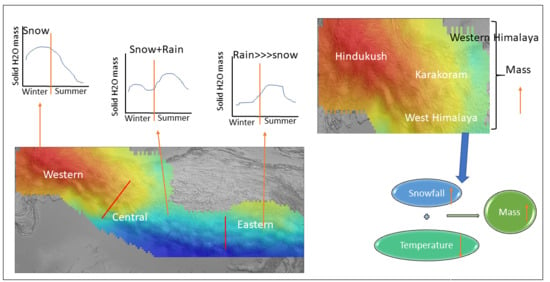Spatio-Temporal Patterns of Mass Changes in Himalayan Glaciated Region from EOF Analyses of GRACE Data
Abstract
:1. Introduction
2. Study Area and Datasets
2.1. Study Area
2.2. Dataset
2.2.1. Time-Varying Gravity
2.2.2. Climatic Variables
3. Methodology
3.1. Statistical Decomposition: EOF
3.2. Granger Causality
4. Results
4.1. Seasonality
4.2. Interannual Variability
4.3. Spatio-Temporal Variations in the Western Himalaya
5. Discussion
5.1. A Summary of the EOF Analysis
GIA
5.2. Western Himalaya
6. Conclusions
Supplementary Materials
Author Contributions
Funding
Data Availability Statement
Acknowledgments
Conflicts of Interest
References
- Bolch, T.; Kulkarni, A.; Kääb, A.; Huggel, C.; Paul, F.; Cogley, J.G.; Frey, H.; Kargel, J.S.; Fujita, K.; Scheel, M.; et al. The state and fate of Himalayan glaciers. Science 2012, 336, 310–334. [Google Scholar] [CrossRef] [PubMed] [Green Version]
- Immerzeel, W.W.; Pellicciotti, F.; Bierkens, M.P.F. Rising river flows throughout the twenty-first century in two Himalayan glacierized watersheds NGEO. Nat. Geosci. 2013, 6, 742–745. [Google Scholar] [CrossRef]
- Fujita, K.; Nuimura, T. Spatially heterogeneous wastage of Himalayan glaciers. Proc. Natl. Acad. Sci. USA 2011, 108, 14011–14014. [Google Scholar] [CrossRef] [PubMed] [Green Version]
- Kääb, A.; Berthier, E.; Nuth, C.; Gardelle, J.; Arnaud, Y. Contrasting patterns of early twenty-first-century glacier mass change in the Himalayas. Nat. Lett. 2012, 488, 495–498. [Google Scholar] [CrossRef] [PubMed]
- Gardner, A.S.; Moholdt, G.; Cogley, J.G.; Wouters, B. A reconciled estimate of glacier contributions to sea level rise: 2003 to 2009. Science 2013, 340, 852–857. [Google Scholar] [CrossRef] [PubMed] [Green Version]
- Gardelle, J.; Berthier, E.; Arnaud, Y. Slight mass gain of Karakoram glaciers in the early twenty-first century. Nat. Geosci. 2012, 5, 322–325. [Google Scholar] [CrossRef]
- Matsuo, K.; Heiki, K. Time-variable ice loss in Asian high mountains from satellite gravimetry. EPS Lett. 2010, 290, 30–36. [Google Scholar] [CrossRef]
- Prajka, J.; Pepe, M.; Rampini, A.; Rossi, S.; Bloschl, G. A regional snow-line method for estimating snow cover from MODIS during cloud cover. J. Hydrol. 2010, 381, 203–212. [Google Scholar] [CrossRef]
- Fujita, K. Effect of precipitation seasonality on climatic sensitivity on glacier mass balance. EPS Lett. 2008, 276, 14–19. [Google Scholar] [CrossRef]
- Kulkarni, A.V.; Bahuguna, I.M.; Rathore, B.P.; Singh, S.K.; Randhawa, S.S.; Sood, R.K.; Dhar, S. Glacial retreat in Himalaya using Remote sensing satellite data. Curr. Sci. 2007, 92, 69–74. [Google Scholar] [CrossRef]
- De Viron, O.; Panet, I.; Diamante, M. Extracting low frequency climate signal from GRACE data. Electron. Earth 2006, 1, 9–14. [Google Scholar]
- Wahr, J.; Molenaar, M.; Bryan, F. Time variability of the earth’s gravity field: Hydrological and oceanic effects and their possible detection using GRACE. J. Geophys. Res. 1998, 103, 30205–30229. [Google Scholar] [CrossRef]
- Landerer, F.W.; Swenson, S.C. Accuracy of scaled GRACE terrestrial water storage estimates. Water Resour. Res. 2012, 48. [Google Scholar] [CrossRef]
- De Viron, O.; Panet, I.; Mikhailov, V.; Van Camp, M.; Diamaent, M. Retrieving earthquake signature in Grace Gravity solutions. Geophys. J. Int. 2008, 174, 14–20. [Google Scholar] [CrossRef] [Green Version]
- Wouters, B.; Schrama, E.J.O. Improved accuracy of GRACE gravity solutions through empirical orthogonal function filtering of spherical harmonics. Geophys. Res. Lett. 2007, 34, L23711. [Google Scholar] [CrossRef] [Green Version]
- Granger, C.W.J. Investigating causal relations by econometric models and cross-spectral methods. Econometrica 1969, 37, 424–438. [Google Scholar] [CrossRef]
- Weiner, N. The theory of prediction. In Modern Mathematics for Engineers; Beckenback, E.F., Ed.; Series 1; McGraw-Hill: New York, NY, USA, 1956. [Google Scholar]
- Attanasio, A.; Passini, A.; Triaca, U. Granger causality analyses for climatic attribution. Atmos. Clim. Sci. 2013, 3, 515–522. [Google Scholar] [CrossRef] [Green Version]
- Kottek, M.; Grieser, J.; Beck, C.; Rudolf, B.; Rubel, F. World Map of the Köppen-Geiger climate classification updated. Meteorol. Z. 2006, 5, 259–263. [Google Scholar] [CrossRef]
- Kulkarni, A.V.; Karyakarte, Y. Observed changes in Himalayan Glaciers. Curr. Sci. 2014, 106, 25. [Google Scholar]
- Save, H.; Bettadpur, S.; Tapley, B.D. High resolution CSR GRACE RL05 mascons. J. Geophys. Res. Solid Earth 2016, 121, 7547–7569. [Google Scholar] [CrossRef]
- Geruo, A.; Wahr, J.; Zhong, S. Computations of the viscoelastic response of a 3-D compressible earth to surface loading: An application to glacial isostatic adjustment in Antarctica and Canada. Geophys. J. Int. 2013, 192, 557–572. [Google Scholar] [CrossRef]
- Peltier, W.R. Global glacial isostasy and the surface of the ice-age Earth: The ICE-5G (VM2) model and Grace. Ann. Rev. Earth Planet. Sci. 2004, 32, 111–149. [Google Scholar] [CrossRef]
- Rodell, M.; Houser, P.R.; Jambor, U.; Gottschalck, J.; Mitchell, K.; Meng, C.-J.; Arsenault, K.; Cosgrove, B.; Radakovich, J.; Bosilovich, M.; et al. The global land data assimilation system. Am. Meteorol. Soc. 2004, 85, 381–394. [Google Scholar] [CrossRef] [Green Version]
- Bolvin, D.T.; Huffman, G.J. Transition of 3B42/3B43 Research Product from Monthly to Climatological Calibration/Adjustment. 2015. Available online: https://gpm.nasa.gov/sites/default/files/document_files/3B42_3B43_TMPA_restart.pdf (accessed on 28 August 2020).
- Randall David, A. Empirical orthogonal functions. In Department of Atmospheric Sciences; Colorado State University: Fort Collins, CO, USA, January 2003. [Google Scholar]
- Toumazou, V.; Creteaux, J.-F. Using a Lancos eigen solver in the computation of Empirical orthogonal functions. Am. Meteorol. Soc. 2001, 219, 1243–1250. [Google Scholar]
- North, G.; Bell Thomas, L.; Cahalan Robert, F. Sampling errors in the estimation of Empirical Orthogonal functions. Am. Meteorol. Soc. 1982, 10, 699–706. [Google Scholar] [CrossRef]
- Forootan, E.; Kursche, J. Separation of global time-variable gravity signals into maximally independent components. J. Geod. 2012, 86, 477–497. [Google Scholar] [CrossRef]
- Mohkov, I.I.; Smirnov, D.; Nakonechny, P.I.; Kozlenko, S.S.; Seleznev, E.P.; Kurths, J. Alternating mutual influence of El Niño/Southern oscillation and Indian monsoon. Geophys. Res. Lett. 2011, 38. [Google Scholar] [CrossRef] [Green Version]
- Kaufmann, R.K.; Seto, K.C.; Schneider, A.; Liu, Z.; Zhou, L.; Wang, W. Climate response to rapid urban growth: Evidence of a human-induced precipitation deficit. J. Clim. 2007, 20, 2299–2306. [Google Scholar] [CrossRef]
- Bookhagen, B.; Burbank, D.W. Towards a complete hydrological budget: Spatiotemporal distribution of snowfall and rainfall and their impact on river discharge. J. Geophs. Res. 2010, 115. [Google Scholar] [CrossRef] [Green Version]
- Tiwari, V.M.; Wahr, J.; Swenson, S. Dwindling groundwater resources in Northern India from satellite gravity observations. Geophys. Res. Lett. 2009, 36, L18401. [Google Scholar] [CrossRef] [Green Version]
- Moiwo, J.P.; Yang, Y.; Tao, F.; Lu, W.; Han, S. Water storage change in the Himalayas from the Gravity Recovery and Climate Experiment (GRACE) and an empirical climate model. WRR 2011, 47, W07521. [Google Scholar] [CrossRef] [Green Version]
- Harrison, T.M.; Copeland, P.; Kidd, W.S.F.; Yin, A. Raising Tibet. Science 1999, 255, 1663. [Google Scholar] [CrossRef] [PubMed] [Green Version]
- Wang, C.; Zhao, X.; Liu, Z.; Lippert Peter, C.; Graham Stephan, A.; Coe Robert, S.; Yi, H.; Zhu, L.; Liu, S.; Li, Y. Constraints on the early uplift history of the Tibetan Plateau. Proc. Natl. Acad. Sci. USA 2008, 105, 4987–4992. [Google Scholar] [CrossRef] [PubMed] [Green Version]
- Xu, C.; Liu, J.; Song, C.; Jiang, W.; Shi, C. GPS measurements of present-day uplift in the Southern Tibet. Lett. Earth Planets Space 2000, 52, 735–739. [Google Scholar] [CrossRef] [Green Version]
- Jiao, J.; Zhang, Y.; Yin, P.; Zhang, K.; Wang, Y.; Bilker-Koivula, M. Changing Moho Beneath the Tibetan plateau revealed by GRACE observations. J. Geophys. Res. Solid Earth 2019, 124. [Google Scholar] [CrossRef]
- Paulson, A.; Zhong, S.; Wahr, J. Inference of mantle viscosity from GRACE and relative sea level data. Geophys. J. Int. 2007, 171, 497–508. [Google Scholar] [CrossRef] [Green Version]
- Stuhne, G.R.; Peltier, W.R. Reconciling the ICE-6G_C reconstruction of glacial chronology with ice sheet dynamics: The cases of Greenland and Antarctica. J. Geophys. Res. Earth Surf. 2015, 120, 1–25. [Google Scholar] [CrossRef] [Green Version]
- Wahr, J.; Wingham, D.; Bentely, C. A method of combining ICESat and GRACE satellite data to constrain Antarctic mass balance. J. Geophys. Res. 2000, 105, 16279–16294. [Google Scholar] [CrossRef]
- Bhambri, R.; Hewitt, K.; Kawishwar, P.; Pratap, B. Surge-type and surge-modified glaciers in the Karakoram. Sci. Rep. 2016, 7, 15391. [Google Scholar] [CrossRef]
- Gardelle, J.; Berthier, E.; Arnaud, Y.; Kääb, A. Region-wide glacier mass balances over the Pamir-Karakoram-Himalaya during 1999–2011. Cryosphere 2013, 7, 1263–1286. [Google Scholar] [CrossRef] [Green Version]
- Bahuguna, I.M.; Rathore, B.P.; Brahmbhatt, R.; Sharma, M.; Dhar Sunil, S.; Randhawa, S.S.; Kumar, K.; Romshoo, S.; Shah, R.D.; Ganjoo, R.K.; et al. Are the Himalayan glaciers retreating? Curr. Sci. 2014, 10, 1008–1013. [Google Scholar]
- Xiao, X.; Moore, B., III; Qin, X.; Shen, Z.; Boles, S. Large-scale observations of alpine snow and ice cover in Asia: Using multi-temporal vegetation sensor data. Int. J. Remote Sens. 2002, 23, 2213–2228. [Google Scholar] [CrossRef] [Green Version]
- Kapnick Sarah, B.; Delworth Thomas, L.; Ashfaq, M.; Malyshev, S.; Milly, P.C.D. Snowfall less sensitive to warming in Karakoram than in Himalayas due to a unique seasonal cycle. Nat. Geosci. 2014, 7, 834–840. [Google Scholar] [CrossRef]
- Dimri, A.P.; Niyogi, D.; Barros, A.P.; Ridley, J.; Mohanty, U.C.; Yasunari, T.; Sikka, D.R. Western Disturbances: A review. Rev. Geophys. 2015, 53, 225–246. [Google Scholar] [CrossRef]
- Azam, M.F.; Ramanathan, A.L.; Wagnon, P.; Vincent, C.; Linda, A.; Berthier, E.; Sharma, P.; Mandal, A.; Angchuk, T.; Singh, V.B.; et al. Meteorological conditions, seasonal and annual mass balances of Chhota Shigri Glacier, western Himalaya, India. Ann. Glaciol. 2016, 57, 328–338. [Google Scholar] [CrossRef] [Green Version]
- Bohmer, J. General climatic controls and topo climatic variation in central High Asia. Boreas 2006, 35, 279–295. [Google Scholar] [CrossRef]

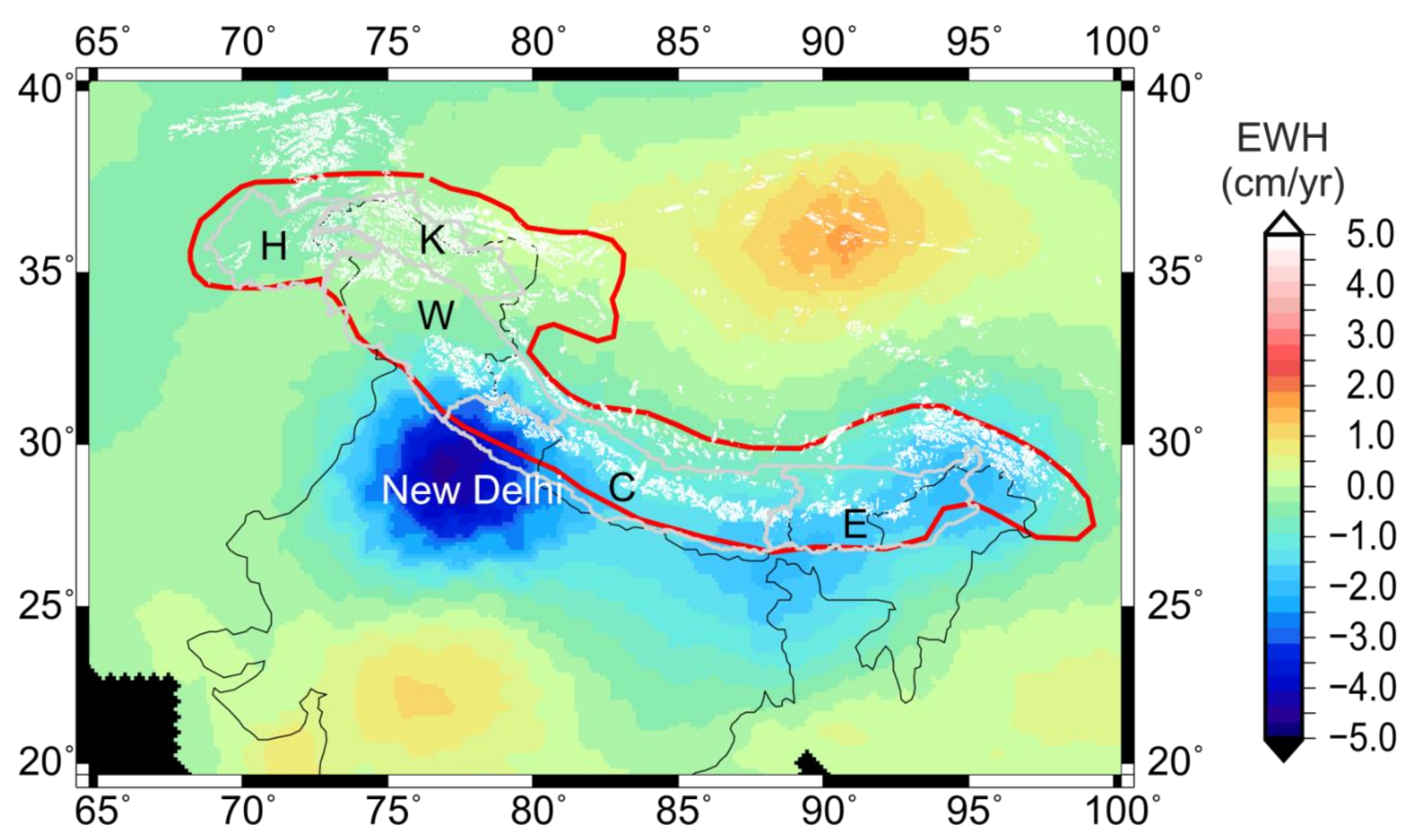
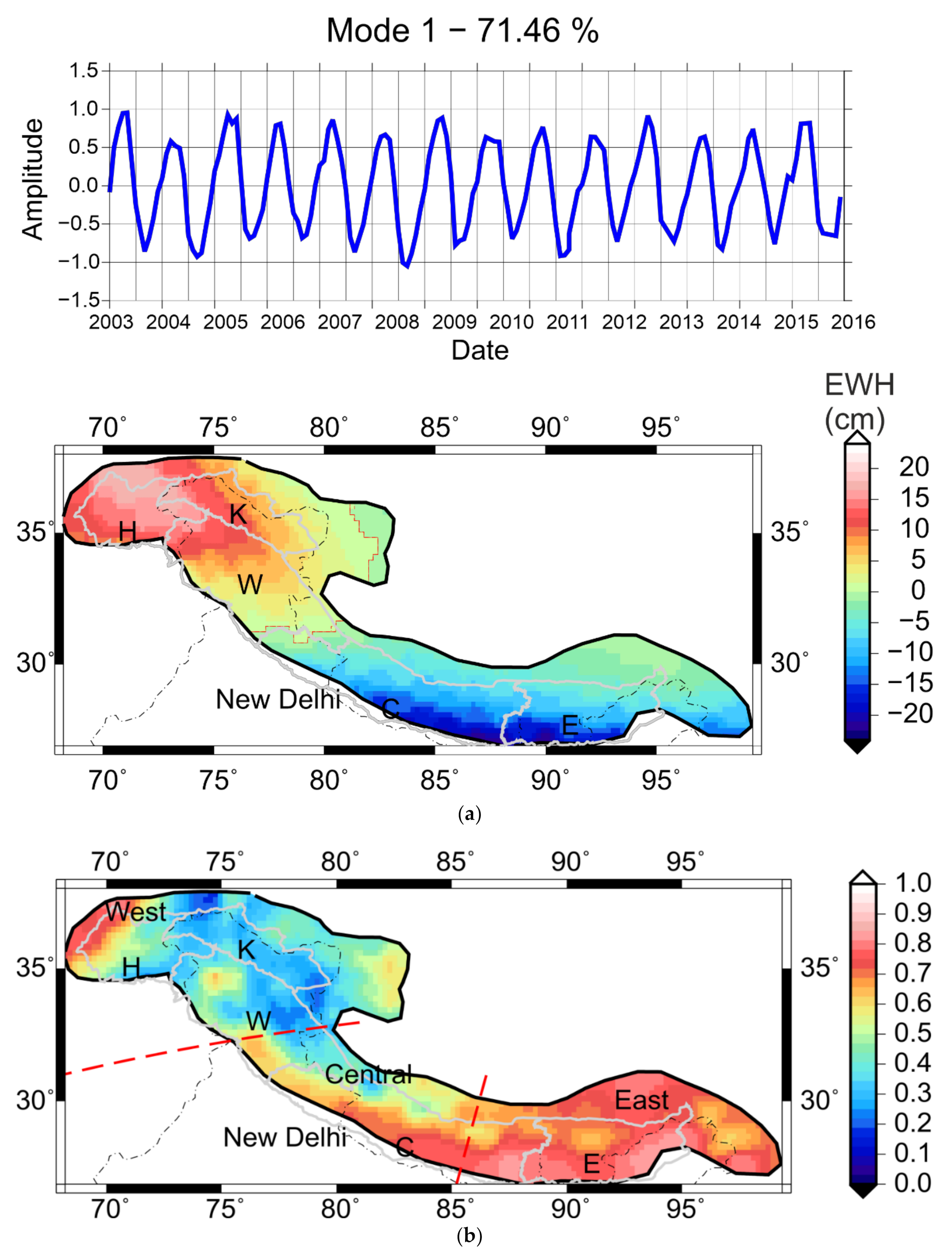


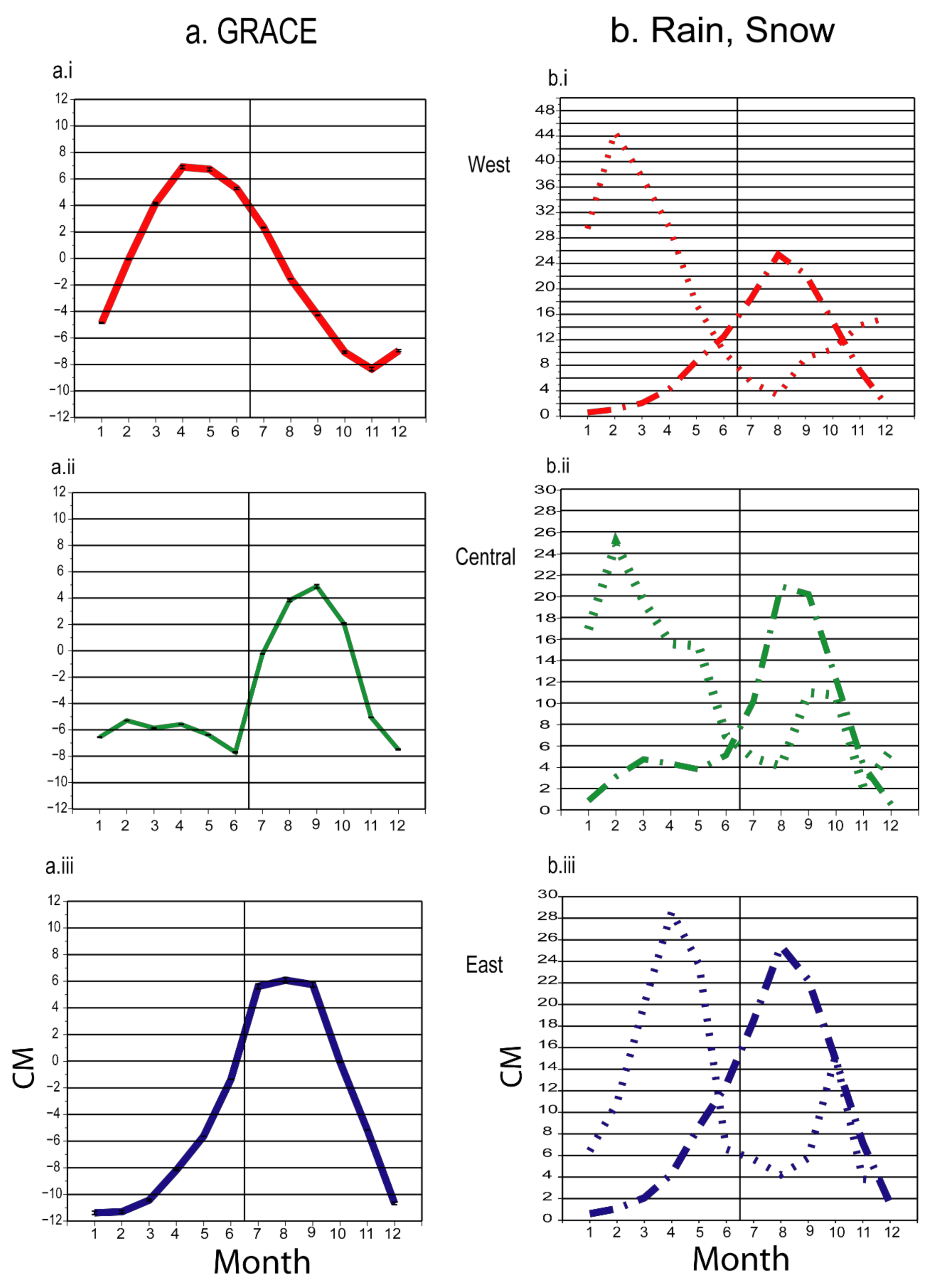
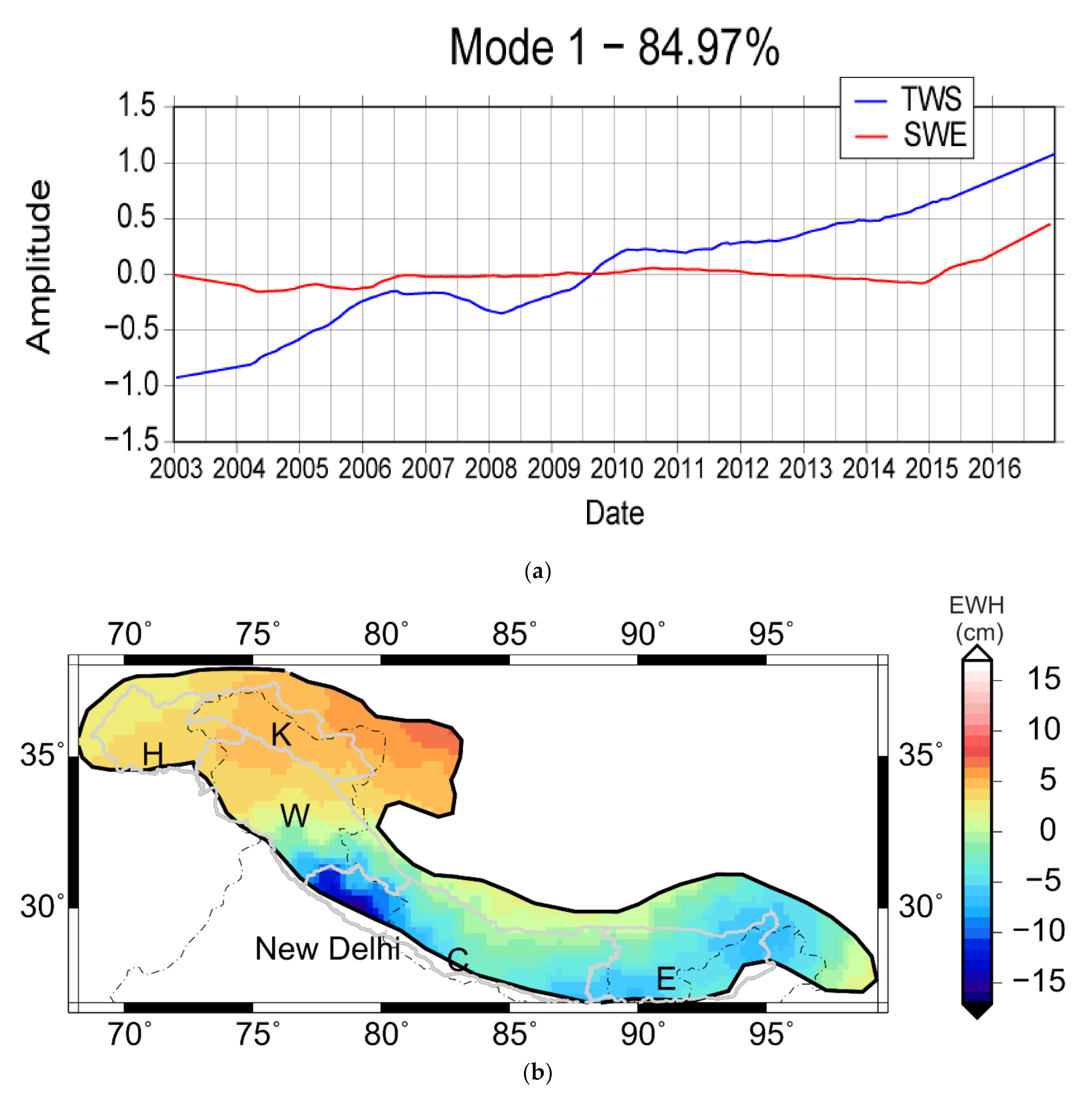
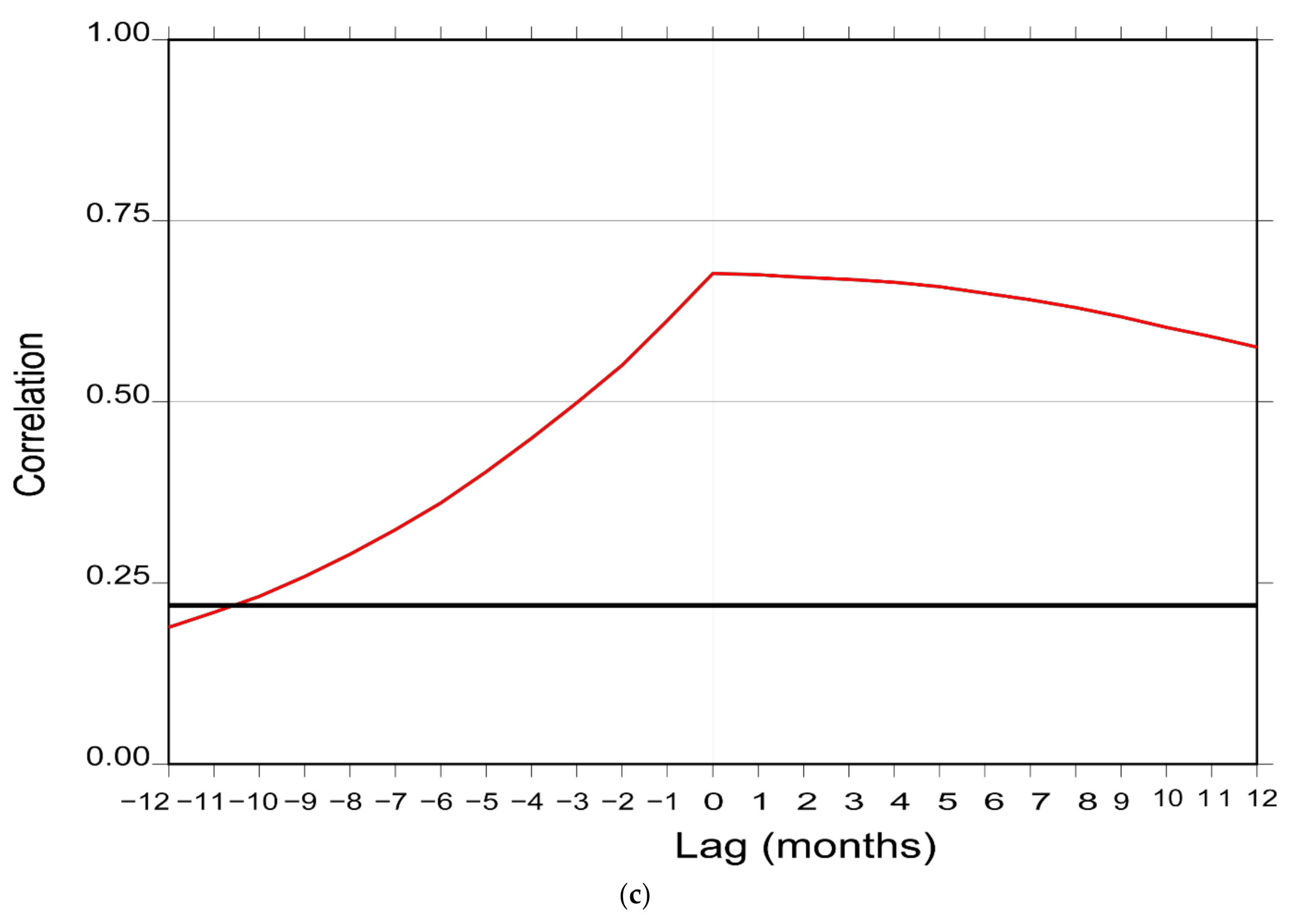
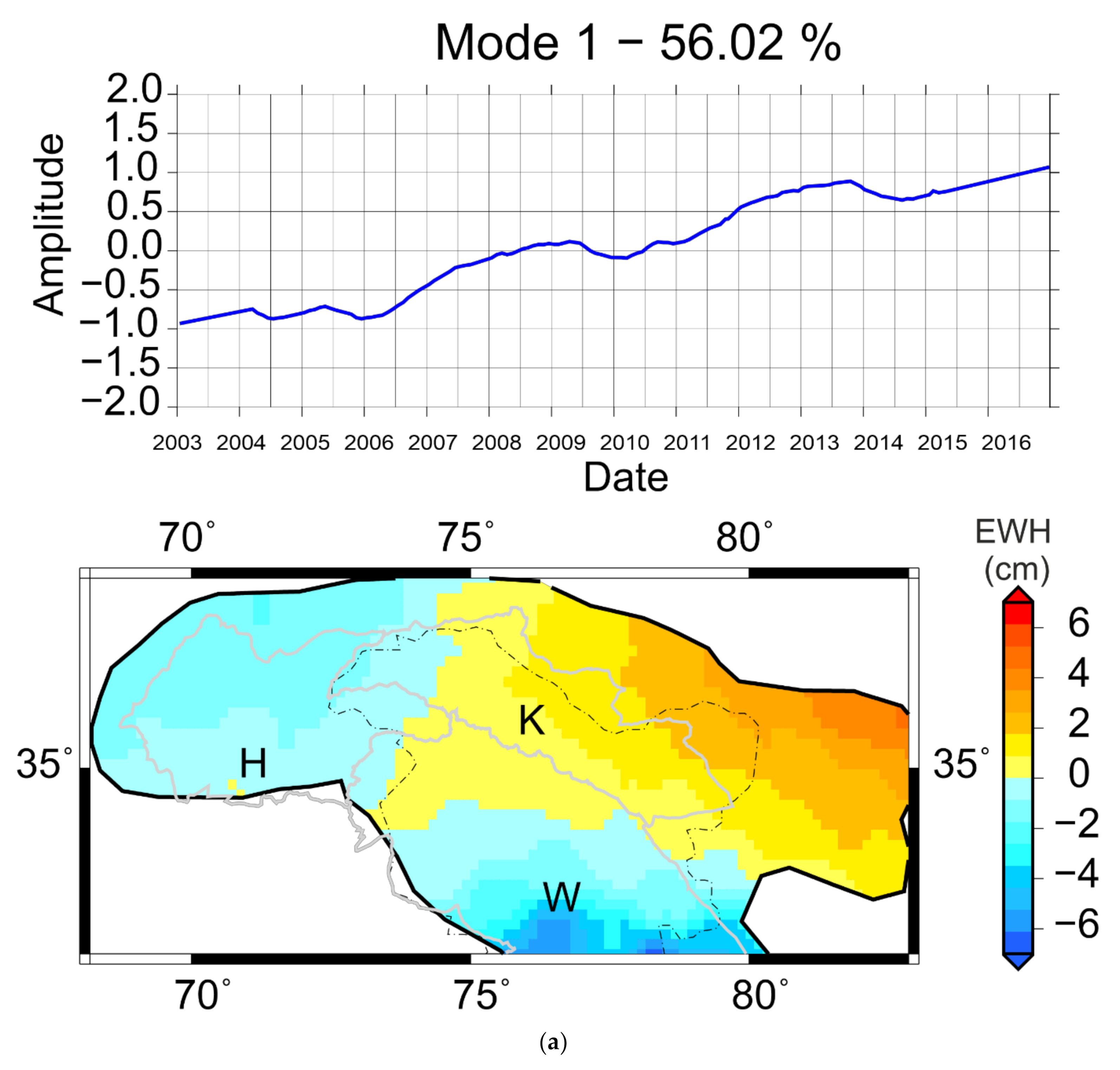
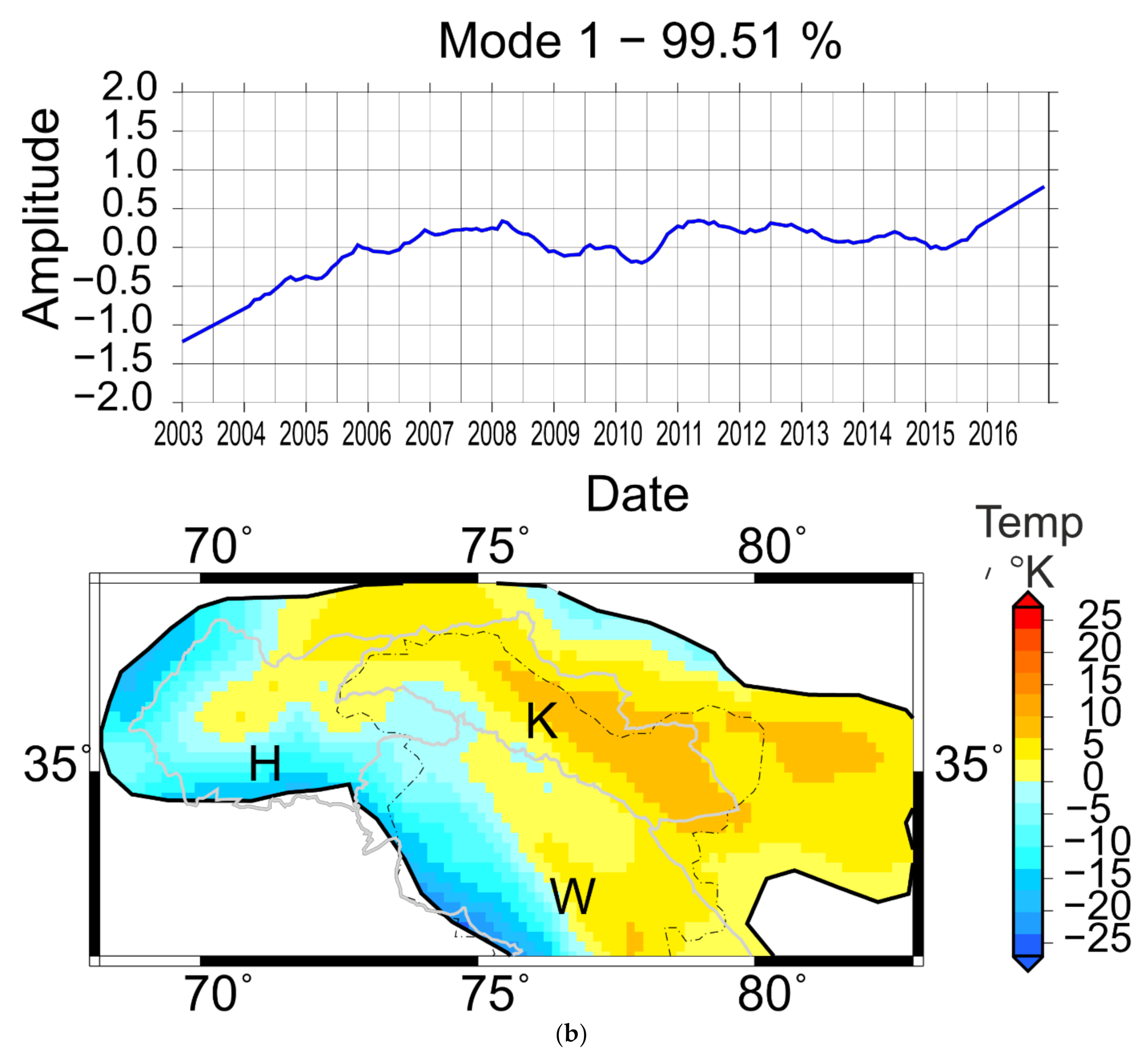
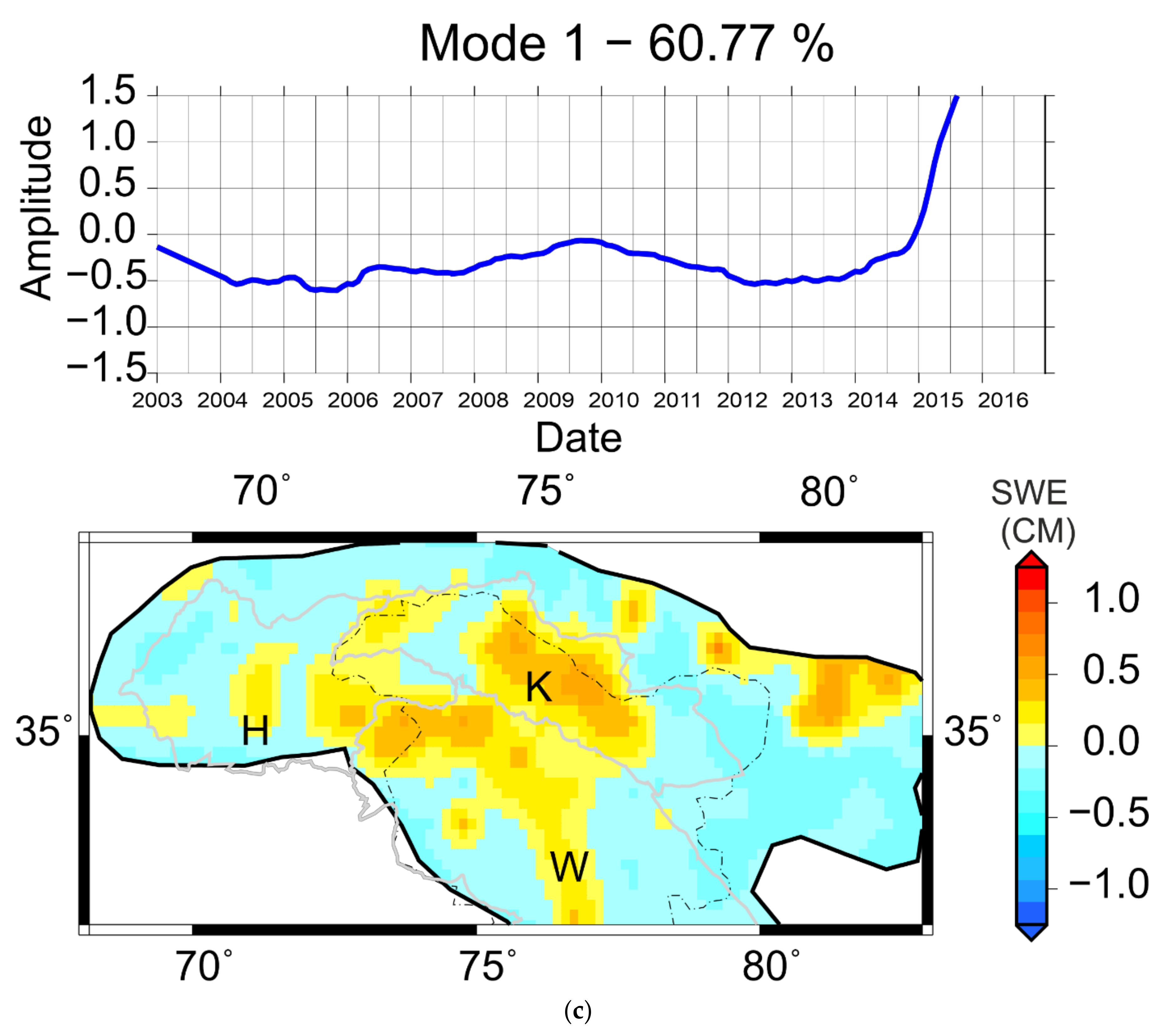
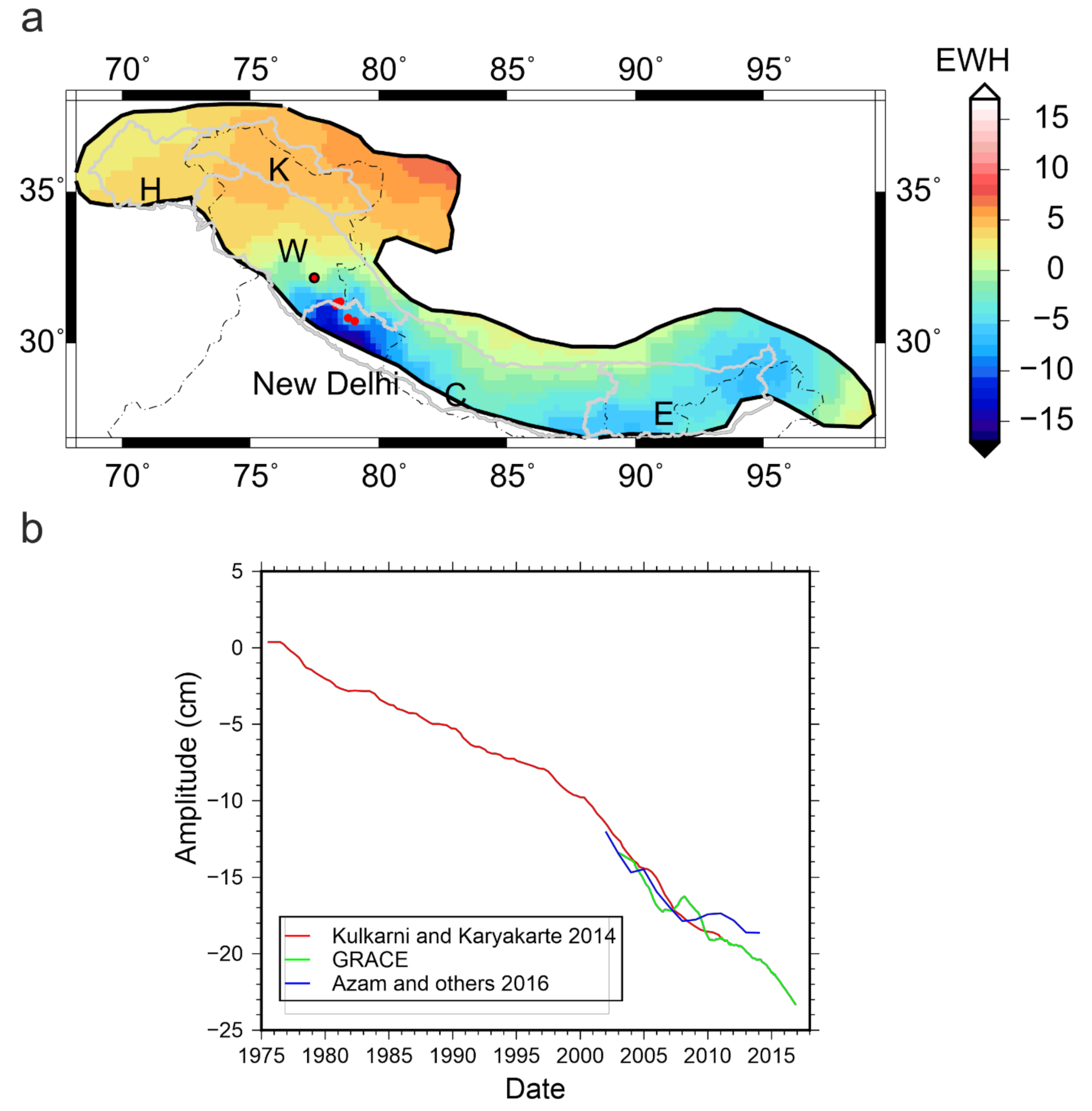
| F-Statistic | Snowfall | Critical Value | Rainfall | Critical Value |
|---|---|---|---|---|
| East | 5.93 | 17.48 | 183.74 | 17.48 |
| Central | 7.96 | 6.79 | 35.7275 | 17.48 |
| West | 12.86 | 5.49 | 8.85 | 17.48 |
| Correlation | Lag | F-Statistic | Critical Value |
|---|---|---|---|
| 0.5 | 0 | 6.87 | 3.9 |
| 0.69 | 0 | 17.69 | 3.9 |
Publisher’s Note: MDPI stays neutral with regard to jurisdictional claims in published maps and institutional affiliations. |
© 2021 by the authors. Licensee MDPI, Basel, Switzerland. This article is an open access article distributed under the terms and conditions of the Creative Commons Attribution (CC BY) license (http://creativecommons.org/licenses/by/4.0/).
Share and Cite
Munagapati, H.; Tiwari, V.M. Spatio-Temporal Patterns of Mass Changes in Himalayan Glaciated Region from EOF Analyses of GRACE Data. Remote Sens. 2021, 13, 265. https://doi.org/10.3390/rs13020265
Munagapati H, Tiwari VM. Spatio-Temporal Patterns of Mass Changes in Himalayan Glaciated Region from EOF Analyses of GRACE Data. Remote Sensing. 2021; 13(2):265. https://doi.org/10.3390/rs13020265
Chicago/Turabian StyleMunagapati, Harika, and Virendra M. Tiwari. 2021. "Spatio-Temporal Patterns of Mass Changes in Himalayan Glaciated Region from EOF Analyses of GRACE Data" Remote Sensing 13, no. 2: 265. https://doi.org/10.3390/rs13020265




